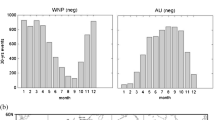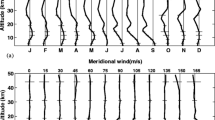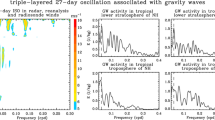Abstract
This study examines the relationship between the MJO and convectively coupled equatorial waves (CCEWs) during the CINDY2011/DYNAMO field campaign using satellite-borne infrared radiation data, in order to better understand the interaction between convection and the large-scale circulation. The spatio-temporal wavelet transform (STWT) enables us to document the convective signals within the MJO envelope in terms of CCEWs in great detail, through localization of space–time spectra at any given location and time. Three MJO events that occurred in October, November, and December 2011 are examined. It is, in general, difficult to find universal relationships between the MJO and CCEWs, implying that MJOs are diverse in terms of the types of disturbances that make up its convective envelope. However, it is found in all MJO events that the major convective body of the MJO is made up mainly by slow convectively coupled Kelvin waves. These Kelvin waves have relatively fast phase speeds of 10–13 m s−1 outside of, and slow phase speeds of ~8–9 m s−1 within the MJO. Sometimes even slower eastward propagating signals with 3–5 m s−1 phase speed show up within the MJO, which, as well as the slow Kelvin waves, appear to comprise major building blocks of the MJO. It is also suggested that these eastward propagating waves often occur coincident with n = 1 WIG waves, which is consistent with the schematic model from Nakazawa in 1988. Some practical aspects that facilitate use of the STWT are also elaborated upon and discussed.










Similar content being viewed by others
Notes
A relatively comprehensive literature list can be found at https://www.eol.ucar.edu/node/471/publications.
The time series of the RMM index can be found at http://poama.bom.gov.au/project/maproom/RMM/, OMI indices are at http://www.esrl.noaa.gov/psd/mjo/mjoindex/ and Bi-ISO index can be found at http://iprc.soest.hawaii.edu/users/kazuyosh/Bimodal_ISO.html.
References
Addison PS (2002) The illustrated wavelet transform handbook: introductory theory and applications in science, engineering, medicine and finance. 1st edn. Taylor & Francis, p 368
Antoine JP, Murenzi R, Vandergheynst P, Ali ST (2004) Two-dimensional wavelets and their relatives. Cambridge University Press, p 458
Benedict JJ, Randall DA (2007) Observed characteristics of the MJO relative to maximum rainfall. J Atmos Sci 64:2332–2354. doi:10.1175/jas3968.1
Chen SS, Houze RA Jr, Mapes BE (1996) Multiscale variability of deep convection in relation to large-scale circulation in TOGA COARE. J Atmos Sci 53:1380–1409
Dias J, Kiladis GN (2014) Influence of the basic state zonal flow on convectively coupled equatorial waves. Geophys Res Lett 41:6904–6913. doi:10.1002/2014gl061476
Dias J, Pauluis O (2011) Modulations of the phase speed of convectively coupled Kelvin waves by the ITCZ. J Atmos Sci 68:1446–1459. doi:10.1175/2011jas3630.1
Dias J, Tulich SN, Kiladis GN (2012) An object-based approach to assessing the organization of tropical convection. J Atmos Sci 69:2488–2504. doi:10.1175/jas-d-11-0293.1
Dias J, Leroux S, Tulich SN, Kiladis GN (2013) How systematic is organized tropical convection within the MJO? Geophys Res Lett 40:1420–1425. doi:10.1002/grl.50308
Dias J, Sakaeda N, Kiladis GN, Kikuchi K (2017) Influences of the MJO on space-time tropical convection organization. J Geophys Res Atmos. doi:10.1002/2017JD026526
Dunkerton TJ, Crum FX (1995) Eastward propagating similar to 2- to 15-day equatorial convection and its relation to the tropical intraseasonal oscillation. J Geophys Res Atmos 100:25781–25790
Emanuel KA, Neelin JD, Bretherton CS (1994) On large-scale circulations in convecting atmospheres. Q J R Meteorol Soc 120:1111–1143
Fujita M, Yoneyama K, Mori S, Nasuno T, Satoh M (2011) Diurnal convection peaks over the eastern Indian Ocean off Sumatra during different MJO phases. J Meteorol Soc Jpn 89A:317–330. doi:10.2151/jmsj.2011-A22
Gottschalck J, Roundy PE, Schreck CJ, Vintzileos A, Zhang C (2013) Large-scale atmospheric and oceanic conditions during the 2011–2012 DYNAMO field campaign. Mon Weather Rev 141:4173–4196. doi:10.1175/mwr-d-13-00022.1
Haertel PT, Johnson RH (1998) Two-day disturbances in the equatorial western Pacific. Q J R Metereol Soc 124:615–636
Haertel PT, Kiladis GN (2004) Dynamics of 2-day equatorial waves. J Atmos Sci 61:2707–2721
Han Y, Khouider B (2010) Convectively coupled waves in a sheared environment. J Atmos Sci 67:2913–2942
Hannah WM, Mapes BE, Elsaesser GS (2016) A Lagrangian view of moisture dynamics during DYNAMO. J Atmos Sci 73:1967–1985. doi:10.1175/jas-d-15-0243.1
Hendon HH, Wheeler MC (2008) Some space-time spectral analyses of tropical convection and planetary-scale waves. J Atmos Sci 65:2936–2948
Hodges KI, Chappell DW, Robinson GJ, Yang G (2000) An improved algorithm for generating global window brightness temperatures from multiple satellite infrared imagery. J Atmos Ocean Technol 17:1296–1312
Hsu HH, Lee MY (2005) Topographic effects on the eastward propagation and initiation of the Madden–Julian oscillation. J Clim 18:795–809
Hung MP, Lin JL, Wang WQ, Kim D, Shinoda T, Weaver SJ (2013) MJO and convectively coupled equatorial waves simulated by CMIP5 climate models. J Clim 26:6185–6214. doi:10.1175/jcli-d-12-00541.1
Ichikawa H, Yasunari T (2007) Propagating diurnal disturbances embedded in the Madden–Julian Oscillation. Geophys Res Lett. doi:10.1029/2007gl030480
Ichikawa H, Yasunari T (2008) Intraseasonal variability in diurnal rainfall over New Guinea and the surrounding oceans during Austral summer. J Clim 21:2852–2868
Janowiak JE, Joyce RJ, Yarosh Y (2001) A real-time global half-hourly pixel-resolution infrared dataset and its applications. Bull Am Meteorol Soc 82:205–217
Johnson RH, Ciesielski PE (2013) Structure and properties of Madden–Julian oscillations deduced from DYNAMO sounding arrays. J Atmos Sci 70:3157–3179
Johnson RH, Ciesielski PE, Ruppert JH Jr, Katsumata M (2015) Sounding-based thermodynamic budgets for DYNAMO. J Atmos Sci 72:598–622. doi:10.1175/jas-d-14-0202.1
Judt F, Chen SS (2014) An explosive convective cloud system and its environmental conditions in MJO initiation observed during DYNAMO. J Geophys Res Atmos 119:2781–2795. doi:10.1002/2013jd021048
Katsumata M, Johnson RH, Ciesielski PE (2009) Observed synoptic-scale variability during the developing phase of an ISO over the Indian Ocean during MISMO. J Atmos Sci 66:3434–3448. doi:10.1175/2009jas3003.1
Kerns BW, Chen SS (2014a) Equatorial dry air intrusion and related synoptic variability in MJO Initiation during DYNAMO. Mon Weather Rev 142:1326–1343. doi:10.1175/mwr-d-13-00159.1
Kerns BW, Chen SS (2014b) ECMWF and GFS model forecast verification during DYNAMO: Multiscale variability in MJO initiation over the equatorial Indian Ocean. J Geophys Res Atmos 119:3736–3755. doi:10.1002/2013jd020833
Kikuchi K (2014) An introduction to combined Fourier-wavelet transform and its application to convectively coupled equatorial waves. Clim Dyn 43:1339–1356. doi:10.1007/s00382-013-1949-8
Kikuchi K, Takayabu YN (2004) The development of organized convection associated with the MJO during TOGA COARE IOP: trimodal characteristics. Geophys Res Lett 31:L10101. doi:10.1029/2004GL019601
Kikuchi K, Wang B (2008) Diurnal precipitation regimes in the global tropics. J Clim 21:2680–2696. doi:10.1175/2007jcli2051.1
Kikuchi K, Wang B (2010) Spatiotemporal wavelet transform and the multiscale behavior of the Madden–Julian oscillation. J Clim 23:3814–3834
Kikuchi K, Wang B, Kajikawa Y (2012) Bimodal representation of the tropical intraseasonal oscillation. Clim Dyn 38:1989–2000. doi:10.1007/s00382-011-1159-1
Kikuchi K, Kodama C, Nasuno T, Nakano M, Miura H, Satoh M, Noda A, Yamada Y (2017) Tropical intraseasonal oscillation in an AMIP-type experiment by NICAM. Clim Dyn. doi:10.1007/s00382-016-3219-z
Kiladis GN, Straub KH, Haertel PT (2005) Zonal and vertical structure of the Madden–Julian oscillation. J Atmos Sci 62:2790–2809
Kiladis GN, Wheeler MC, Haertel PT, Straub KH, Roundy PE (2009) Convectively coupled equatorial waves. Rev Geophys 47:RG2003. doi:10.1029/2008RG000266
Kiladis GN, Dias J, Straub KH, Wheeler MC, Tulich SN, Kikuchi K, Weickmann KM, Ventrice MJ (2014) A comparison of OLR and circulation-based indices for tracking the MJO. Mon Weather Rev 142:1697–1715. doi:10.1175/mwr-d-13-00301.1
Kiladis GN, Dias J, Gehne M (2016) The relationship between equatorial mixed Rossby-gravity and eastward inertio-gravity waves. Part I. J Atmos Sci 73:2123–2145. doi:10.1175/jas-d-15-0230.1
Kiranmayi L, Maloney ED (2011) Intraseasonal moist static energy budget in reanalysis data. J Geophys Res Atmos. doi:10.1029/2011jd016031
Kubota H, Yoneyama K, Hamada J-I, Wu P, Sudaryanto A, Wahyono IB (2015) Role of Maritime Continent convection during the preconditioning stage of the Madden–Julian oscillation observed in CINDY2011/DYNAMO. J Meteorol Soc Jpn 93A:101–114. doi:10.2151/jmsj.2015-050
Kumar P, FoufoulaGeorgiou E (1997) Wavelet analysis for geophysical applications. Rev Geophys 35:385–412
Lau WKM, Waliser D (eds) (2012) Intraseasonal variability in the atmosphere–ocean climate system. 2nd edn. Springer, p 614
Madden RA, Julian PR (1971) Detection of a 40–50 day oscillation in the zonal wind in the tropical Pacific. J Atmos Sci 28:702–708
Madden RA, Julian PR (1972) Description of global-scale circulation cells in tropics with a 40–50 day period. J Atmos Sci 29:1109–1123
Majda AJ, Stechmann SN (2012) Multiscale theories for the MJO. Intraseasonal variability in the atmosphere–ocean climate system, 2nd edn. Lau KM, Waliser DE (eds) Springer, pp 549–585
Maloney ED, Hartmann DL (1998) Frictional moisture convergence in a composite life cycle of the Madden–Julian oscillation. J Clim 11:2387–2403
Mapes BE, Houze RA Jr (1993) Cloud clusters and superclusters over the oceanic warm pool. Mon Weather Rev 121:1398–1415
Masunaga H (2007) Seasonality and regionality of the Madden–Julian oscillation, Kelvin wave, and equatorial Rossby wave. J Atmos Sci 64:4400–4416. doi:10.1175/2007jas2179.1
Masunaga H, L’Ecuyer TS, Kummerow CD (2006) The Madden–Julian oscillation recorded in early observations from the tropical rainfall measuring mission (TRMM). J Atmos Sci 63:2777–2794
Matsuno T (1966) Quasi-geostrophic motions in the equatorial area. J Meteorol Soc Jpn 44:25–43
Meyers SD, Kelly BG, Obrien JJ (1993) An introduction to wavelet analysis in oceanography and meteorology: with application to the dispersion of Yanai waves. Mon Weather Rev 121:2858–2866
Miyakawa T, Takayabu YN, Nasuno T, Miura H, Satoh M, Moncrieff MW (2012) Convective momentum transport by rainbands within a Madden–Julian oscillation in a global nonhydrostatic model with explicit deep convective processes. Part I: Methodology and general results. J Atmos Sci 69:1317–1338. doi:10.1175/jas-d-11-024.1
Mori S, Jun-Ichi H, Tauhid YI, Yamanaka MD (2004) Diurnal land–sea rainfall peak migration over Sumatera Island, Indonesian maritime continent, observed by TRMM satellite and intensive rawinsonde soundings. Mon Weather Rev 132:2021–2039
Nakazawa T (1988) Tropical super clusters within intraseasonal variations over the western Pacific. J Meteorol Soc Jpn 66:823–839
Nasuno T, Li T, Kikuchi K (2015) Moistening processes before the convective initiation of Madden–Julian oscillation events during the CINDY2011/DYNAMO period. Mon Weather Rev 143:622–643. doi:10.1175/mwr-d-14-00132.1
Oh J-H, Kim K-Y, Lim G-H (2012) Impact of MJO on the diurnal cycle of rainfall over the western Maritime Continent in the Austral summer. Clim Dyn 38:1167–1180. doi:10.1007/s00382-011-1237-4
Peatman SC, Matthews AJ, Stevens DP (2014) Propagation of the Madden–Julian oscillation through the Maritime Continent and scale interaction with the diurnal cycle of precipitation. Q J R Meteorol Soc 140:814–825. doi:10.1002/qj.2161
Powell SW, Houze RA Jr (2015a) Effect of dry large-scale vertical motions on initial MJO convective onset. J Geophys Res Atmos 120:4783–4805. doi:10.1002/2014jd022961
Powell SW, Houze RA Jr (2015b) Evolution of precipitation and convective echo top heights observed by TRMM radar over the Indian Ocean during DYNAMO. J Geophys Res Atmos 120:3906–3919. doi:10.1002/2014jd022934
Powell SW, Houze RA, Jr. (2013) The cloud population and onset of the Madden–Julian Oscillation over the Indian Ocean during DYNAMO-AMIE. J Geophys Res Atmos 118:11979–11995, doi:10.1002/2013jd020421
Rauniyar SP, Walsh KJE (2011) Scale interaction of the diurnal cycle of rainfall over the Maritime Continent and Australia: influence of the MJO. J Clim 24:325–348. doi:10.1175/2010jcli3673.1
Ridout JA, Flatau MK (2011) Kelvin wave time scale propagation features of the Madden–Julian Oscillation (MJO) as measured by the Chen-MJO index. J Geophys Res Atmos. doi:10.1029/2011jd015925
Roundy PE (2008) Analysis of convectively coupled Kelvin waves in the Indian ocean MJO. J Atmos Sci 65:1342–1359
Roundy PE (2012) Observed structure of convectively coupled waves as a function of equivalent depth: Kelvin waves and the Madden–Julian Oscillation. J Atmos Sci 69:2097–2106. doi:10.1175/jas-d-12-03.1
Roundy PE (2014) Regression analysis of zonally narrow components of the MJO. J Atmos Sci 71:4253–4275. doi:10.1175/jas-d-13-0288.1
Roundy PE, Frank WM (2004) A climatology of waves in the equatorial region. J Atmos Sci 61:2105–2132
Serra YL, Kiladis GN, Cronin MF (2008) Horizontal and vertical structure of easterly waves in the Pacific ITCZ. J Atmos Sci 65:1266–1284
Sobel A, Wang S, Kim D (2014) Moist static energy budget of the MJO during DYNAMO. J Atmos Sci 71:4276–4291. doi:10.1175/jas-d-14-0052.1
Takayabu YN (1994a) Large-scale cloud disturbances associated with equatorial waves. Part I: Spectral features of the cloud disturbances. J Meteorol Soc Jpn 72:433–449
Takayabu YN (1994b) Large-scale cloud disturbances associated with equatorial waves. Part II: Westward-propagating inertio-gravity waves. J Meteorol Soc Japan 72:451–465
Takayabu YN, Nitta T (1993) 3–5 day-period disturbances coupled with convection over the tropical Pacific Ocean. J Meteorol Soc Jpn 71:221–246
Takayabu YN, Lau KM, Sui CH (1996) Observation of a quasi-2-day wave during TOGA COARE. Mon Weather Rev 124:1892–1913
Torrence C, Compo GP (1998) A practical guide to wavelet analysis. Bull Am Meteorol Soc 79:61–78
Waliser D (2012) Predictability and forecasting. Intraseasonal variability in the atmosphere–ocean climate system, 2nd edn. Lau WKM, Waliser DE (eds) Praxis Publishing, pp 433–476
Wang B (2012) Theories. Intraseasonal variability in the atmosphere–ocean climate system, 2nd edn. Lau KM, Waliser DE (eds) Springer, pp 335–398
Wheeler MC, Hendon HH (2004) An all-season real-time multivariate MJO index: development of an index for monitoring and prediction. Mon Weather Rev 132:1917–1932
Wheeler M, Kiladis GN (1999) Convectively coupled equatorial waves: analysis of clouds and temperature in the wavenumber-frequency domain. J Atmos Sci 56:374–399
Wilks DS (2006) Statistical methods in the atmospheric sciences. 2nd edn. Academic Press, p 648
Wu C-H, Hsu H-H (2009) Topographic influence on the MJO in the maritime continent. J Clim 22:5433–5448. doi:10.1175/2009jcli2825.1
Yamada H, Yoneyama K, Katsumata M, Shirooka R (2010) Observations of a super cloud cluster accompanied by synoptic-scale eastward-propagating precipitating systems over the Indian Ocean. J Atmos Sci 67:1456–1473
Yang GY, Slingo J (2001) The diurnal cycle in the tropics. Mon Weather Rev 129:784–801
Yang G-Y, Slingo J, Hoskins B (2009) Convectively coupled equatorial waves in high-resolution Hadley Centre climate models. J Clim 22:1897–1919. doi:10.1175/2008jcli2630.1
Yasunaga K, Mapes B (2012) Differences between more divergent and more rotational types of convectively coupled equatorial waves. Part II: Composite analysis based on space-time filtering. J Atmos Sci 69:17–34
Yokoi S, Sobel A (2015) Intraseasonal variability and seasonal march of the moist static energy budget over the eastern Maritime Continent during CINDY2011/DYNAMO. J Meteorol Soc Jpn 93A:81–100. doi:10.2151/jmsj.2015-041
Yoneyama K, Zhang C, Long CN (2013) Tracking pulses of the Madden–Julian oscillation. Bull Am Meteorol Soc 94:1871–1891. doi:10.1175/bams-d-12-00157.1
Zhang CD (2005) Madden–Julian oscillation. Rev Geophys 43:RG2003. doi:10.1029/2004RG000158
Zhang CD (2013) Madden–Julian oscillation: bridging weather and climate. Bull Am Meteorol Soc 94:1849–1870. doi:10.1175/bams-d-12-00026.1
Zhao C, Li T, Zhou T (2013) Precursor signals and processes associated with MJO initiation over the tropical Indian Ocean. J Clim 26:291–307. doi:10.1175/jcli-d-12-00113.1
Acknowledgements
This research was supported by NOAA Grant NA13OAR4310165. Additional support was provided by the JAMSTEC through its sponsorship of research activities at the IPRC (JIJI). These results were obtained using the globally-merged full resolution Tb brightness temperature data provided by the climate prediction center/NCEP/NWS (available at http://disc.sci.gsfc.nasa.gov/precipitation/data-holdings/Globally_merged_IR.shtml). The authors acknowledge the use of a package provided by CCSM AMWG to compute Fourier-based zonal wavenumber-frequency power spectrum. We thank three reviewers for their insightful comments. We also benefited from discussion with Paul E. Roundy and Masaki Katsumata. School of Ocean and Earth Science and Technology contribution number 10222 and International Pacific Research Center contribution number 1288.
Author information
Authors and Affiliations
Corresponding author
Appendix: Energy conversion from STWT space to Fourier space
Appendix: Energy conversion from STWT space to Fourier space
Presenting the calculated STWT spectra in its native space (as a function of scale and speed tuning parameter) makes the STWT difficult to compare with popular FT approaches and hinders interpretation. In order to fill the gap in representation, we developed a method to convert the STWT spectra in terms of zonal wavenumber and frequency. By considering how a sinusoidal wave can be represented in the STWT and FT, \(a\) and \(c\) can be associated with \(k\) and \(\omega\) as follows (Kikuchi and Wang 2010):
where \({k_M}={k_0}+{\left( {k_{0}^{2}+2} \right)^{1/2}},\quad {\omega _M}={\omega _0}+{\left( {\omega _{0}^{2}+2} \right)^{1/2}}.\)
In light of the energy conservation (3), the discretized STWT spectrum \({\mathop {\tilde{W}}\nolimits^{} _{i,n}}\) in Fourier space at zonal wavenumber \({k_i}\) and frequency \({f_n}\) can be estimated using the computed STWT spectrum \({W_{j,q}}\) at \({a_j}\) and \({c_q}\) as
where \({\alpha _{i,n;j,q}}\) is the coefficient that measures the ratio of the area of the segment \((j,q)\) enclosed by the curves \(P_{1}^{'},~P_{2}^{'},~P_{3}^{'},~P_{4}^{'}\) to the total area of the segment \((j,q)\) (Fig. 11), and \(\Delta k\) and \(\Delta f\) are the desired zonal wavenumber and frequency resolutions of the \({\mathop {\tilde{W}}\nolimits^{} _{i,n}}\) spectrum in the Fourier space.
Schematic illustrating how the STWT spectra are represented in terms of the Fourier space. a Spectrum at zonal wavenumber k and frequency f represents the energy contained in a rectangular defined by \({P_1}\left( {{{k - \Delta k} \mathord{\left/ {\vphantom {{k - \Delta k} 2}} \right. \kern-0pt} 2},\;{{f - \Delta f} \mathord{\left/ {\vphantom {{f - \Delta f} 2}} \right. \kern-0pt} 2}} \right),\quad {P_2}\left( {{{k+\Delta k} \mathord{\left/ {\vphantom {{k+\Delta k} 2}} \right. \kern-0pt} 2},\;{{f - \Delta f} \mathord{\left/ {\vphantom {{f - \Delta f} 2}} \right. \kern-0pt} 2}} \right),\;{P_3}\left( {{{k+\Delta k} \mathord{\left/ {\vphantom {{k+\Delta k} 2}} \right. \kern-0pt} 2},\;{{f+\Delta f} \mathord{\left/ {\vphantom {{f+\Delta f} 2}} \right. \kern-0pt} 2}} \right),\;{P_4}\left( {{{k - \Delta k} \mathord{\left/ {\vphantom {{k - \Delta k} 2}} \right. \kern-0pt} 2},\;{{f+\Delta f} \mathord{\left/ {\vphantom {{f+\Delta f} 2}} \right. \kern-0pt} 2}} \right)\) and b the corresponding energy represented in the wavelet domain. The curves \(P_{1}^{\prime },\;P_{2}^{\prime },\;P_{3}^{\prime },\;P_{4}^{\prime },\) are obtained by means of Eq. (13)
Rights and permissions
About this article
Cite this article
Kikuchi, K., Kiladis, G.N., Dias, J. et al. Convectively coupled equatorial waves within the MJO during CINDY/DYNAMO: slow Kelvin waves as building blocks. Clim Dyn 50, 4211–4230 (2018). https://doi.org/10.1007/s00382-017-3869-5
Received:
Accepted:
Published:
Issue Date:
DOI: https://doi.org/10.1007/s00382-017-3869-5





